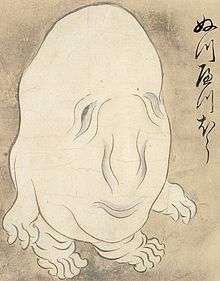Nuppeppō

In Japanese folklore the Nuppeppō (Japanese: ぬっぺっぽう) - also known as Nuppefuhō (Japanese: ぬっぺふほう) - is a genderless Yōkai (Japanese: 妖怪, "monster" or "goblin") described as having a flabby appearance and a pungent body odor. It appears as a blob of flesh with a hint of a face in the folds of fat. Though largely amorphous, fingers, toes, and even rudimentary limbs may be attributed as features amidst the fold of skin.[1] The name Nuppeppō is a corruption of the derogatory slang Nupperi (ぬっぺり), used to describe a woman who applies too much makeup.[2] This is most likely a reference to the creature's saggy appearance, which is similar to the sagging of a face under heavy makeup.
The Nuppeppō is passive and almost entirely harmless, but it has a repulsive body odor is said to rival that smell of rotting flesh. Other theories claim that the Nuppeppō is actually decaying flesh. There is a rumor that states that those who eat the flesh of a Nuppeppō shall have eternal youth.[2][3]
The Nuppeppō aimlessly wanders deserted streets of villages, towns and cities, often at night towards the year-end, or graveyards or abandoned temples. It is usually a solitary creature, but there have reportedly been sightings of them in groups.[2] If encountered, the Nuppeppō is unlikely to cause a human any harm. However, its lumbering stature and foul odor may cause shock and alarm.
While the origins of the Nuppeppō are unknown, there are those who believe that it is a creature comprising the flesh of dead humans cobbled together in a manner not dissimilar to Frankenstein's monster. However, no motivation is made clear as to why anybody would want to construct such a creature.[2]
References in Japanese culture

Illustrations of the Nuppeppō can be found in works such as the 1737 Hyakkai Zukan (Japanese: 百怪図巻, lit. "The Illustrated Volume of a Hundred Demons") by author Sawaki Suushi.[4] Later illustrations can be found in the works of Toriyama Sekien, starting with his 1776 publication Gazu Hyakki Yagyō (Japanese: 画図百鬼夜行, lit. "The Illustrated Night Parade of One Hundred Demons".)[5]
Author Mizuki Shigeru also features the Nuppeppō in his popular GeGeGe no Kitarō manga and anime series, as well as in his encyclopaedic book of Yōkai, Yōkai Jiten (Japanese: 妖怪事典, lit. "Yōkai encyclopaedia.)[6]
One famous story concerning the Nuppeppō was written by 18th century scribe Makibokusen, who wrote a scroll describing the appearance of a creature matching the description of the Nuppeppō at the Castle of Shogun Tokugawa Ieyasu. According to the story, Tokugawa orders that the creature be sent away to the mountains - unharmed - that it may be kept safe and clear of human settlements. Later, Tokugawa learns that the creature is noted in Chinese literature as being a "sovereign specific", endowed with powers of restoration.[2]
The Nuppeppō has also made appearances in various cinematic productions, most notably the Yokai Monsters trilogy. In Yokai Monsters: Spook Warfare, the Nuppeppō is seen alongside a roster of other traditional Yōkai helping to fend off a Babylonian invader.
References
- ↑ Clayton, James (2010-02-20). "One Hundred Mythical Creatures in Haiku: Day LXXXII - Nuppeppo". Hundredmythologyhaiku.blogspot.com. Retrieved 2015-10-24.
- 1 2 3 4 5 Yoda, Hiroko; Morino, Matt Alt ; illustrations by Tatsuya (2008). Yokai attack! : the Japanese monster survival guide (1st ed.). Tokyo: Kodansha International. pp. 177–180. ISBN 9784770030702.
- ↑ Foster, Michael Dylan (2014). Book of yokai : mysterious creatures of japanese folklore. [S.l.]: Univ Of California Press. pp. 207–211. ISBN 0520271025.
- ↑ Yumoto, Goichi (2006). 続・妖怪図巻. Tokyo: Kokushokankokai. pp. 1–154. ISBN 9784336047786.
- ↑ Sekien, Toriyama (2005). Toriyama Sekien Gazu hyakki yakō zen gashū (Dai 4-han. ed.). Tōkyō: Kadokawa shoten. ISBN 4-04-405101-1.
- ↑ Mizuki, Shigeru (August 1981). 水木しげるの妖怪事典. Tokyo: Tokyo-do publication. ISBN 449010149X.
